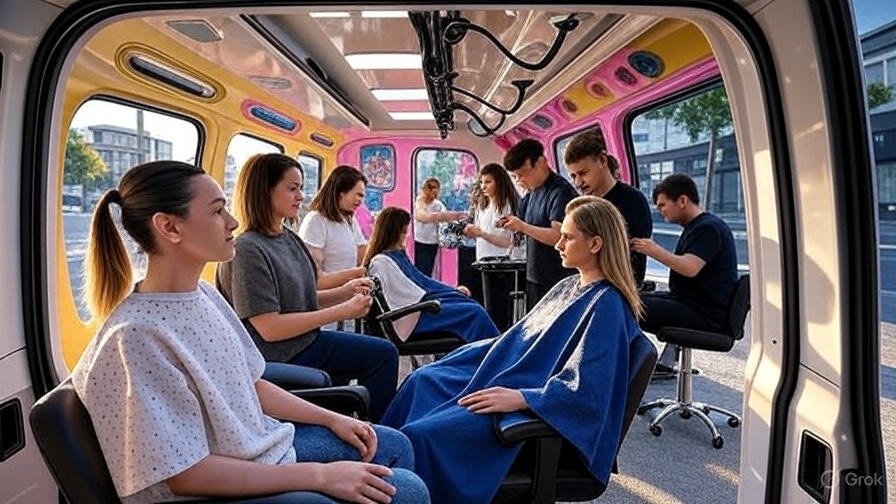Mobile Salons and Pop-Up Services: The Future of Beauty in America

Content
The beauty industry is undergoing a revolutionary transformation, and it’s rolling up to your doorstep in the form of mobile salons and pop-up services. What was once considered a novelty has rapidly evolved into a fundamental shift in how Americans access beauty and wellness services, driven by changing consumer preferences, technological advances, and the lasting impact of the pandemic.
The Rise of Beauty on Wheels
Mobile beauty services have exploded in popularity over the past decade, with the market experiencing unprecedented growth. Today, you can find everything from basic manicures and makeup applications to full-service haircuts and spa treatments delivered directly to your home, office, or special event location.
This trend isn’t just about convenience—it’s about redefining the traditional beauty service model. Gone are the days when getting a quality haircut required driving across town and spending hours between clients. Mobile beauty professionals are bringing salon-quality services to clients on their own terms, offering personalized experiences in familiar, comfortable environments.
What’s Driving the Mobile Beauty Boom?
Several factors have converged to create the perfect storm for mobile beauty services:
Time Constraints: Modern Americans are busier than ever. Mobile services eliminate travel time and waiting room delays, making it possible to squeeze in beauty appointments during lunch breaks, before important meetings, or while supervising children.
Personalized Experience: There’s something inherently luxurious about having a beauty professional cater exclusively to you. Mobile services often provide more one-on-one attention than crowded salons, with practitioners able to focus entirely on their client’s needs.
Health and Safety Concerns: The pandemic forever changed how we think about shared spaces. Mobile services offer a safer alternative, providing sanitized, private environments that feel more hygienic than traditional salons.
Technology Integration: Advanced booking apps, portable styling tools, and high-speed internet have made professional mobile services more reliable and accessible than ever before.
Pop-Up Services: Beauty’s Newest Retail Revolution
While mobile services bring beauty professionals to consumers, pop-up services are bringing beauty experiences to unexpected places. From shopping mall kiosks and hotel lobbies to corporate office buildings and festival grounds, pop-up beauty services are democratizing access to premium beauty treatments.
These temporary installations offer several unique advantages:
Lower Overhead Costs: Pop-ups allow beauty professionals to serve more clients without the burden of rent and utilities, making quality services more affordable for consumers.
Market Testing: For beauty brands and new entrepreneurs, pop-ups provide low-risk opportunities to test new markets and services.
Event Integration: Whether it’s wedding shows, corporate events, or music festivals, pop-ups seamlessly integrate beauty services into existing social gatherings.
Community Building: Pop-ups often create buzz and foster community engagement, turning routine beauty appointments into social experiences.
The Technology Edge
Modern mobile and pop-up beauty services leverage cutting-edge technology to deliver professional results anywhere:
Portable Professional Equipment: Today’s mobile beauty professionals use lightweight, professional-grade tools that rival what you’d find in high-end salons.
Advanced Booking Systems: Smartphone apps allow instant booking, payment processing, and service customization, making mobile beauty services as easy to access as ride-sharing.
Social Media Integration: Many mobile beauty businesses thrive on social media marketing, showcasing their work and building communities of loyal clients online.
Economic Impact and Industry Opportunities
The mobile beauty sector represents significant economic opportunity:
Job Creation: The industry has created flexible employment opportunities for licensed beauty professionals seeking work-life balance.
Entrepreneurship: Many mobile beauty practitioners are business owners, contributing to the gig economy and small business growth.
Market Expansion: Mobile services are reaching underserved populations, including elderly clients, busy professionals, and those in rural areas with limited access to traditional beauty services.
Challenges and Considerations
Despite rapid growth, the mobile beauty industry faces several challenges:
Regulatory Compliance: Licensing requirements vary significantly between states and municipalities, creating complexity for mobile practitioners.
Equipment and Supply Management: Mobile professionals must carefully manage inventory, equipment maintenance, and sanitation protocols.
Insurance and Liability: Operating outside traditional salon environments requires specialized insurance coverage and risk management strategies.
The Road Ahead
Industry experts predict continued growth for mobile and pop-up beauty services, with several emerging trends shaping the future:
Specialization: We’re seeing increased specialization, with mobile services focusing on specific demographics (bridal, corporate, elderly care) or treatments (skincare, permanent makeup, medical aesthetics).
Corporate Partnerships: Major beauty brands are experimenting with mobile service partnerships to expand their reach and customer engagement.
Sustainability Focus: Many mobile beauty businesses are emphasizing eco-friendly practices, using sustainable products and reducing the carbon footprint associated with client travel.
Integration with Wellness: Mobile beauty services are increasingly combining with wellness offerings like massage therapy, nutrition counseling, and mental health support.
Conclusion
Mobile salons and pop-up beauty services represent more than just a convenient alternative to traditional salons—they’re reshaping how Americans think about beauty, wellness, and service delivery. As technology continues to advance and consumer preferences evolve, these services are positioned to become an integral part of America’s beauty landscape.
The future of beauty in America is mobile, flexible, and deeply personalized. Whether rolling up to your front door or popping up at your favorite shopping center, these innovative service models are making professional beauty care more accessible, convenient, and tailored to modern lifestyles than ever before.
As we move forward, the beauty industry’s success will increasingly depend on its ability to adapt to these changing consumer expectations, embracing mobility and flexibility as essential components of customer satisfaction in an increasingly fast-paced world.
